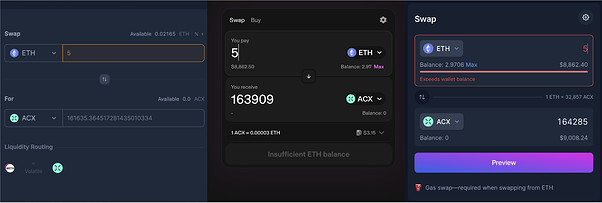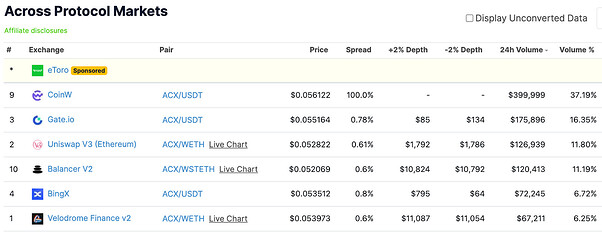Summary
Deploy Arrakis PALM to conduct market making for ACX on Mainnet UniV3, with POL allocated from Across DAO.
Introduction to Arrakis Finance and Arrakis PALM
Arrakis Finance Web3’s trustless market making protocol that enables running sophisticated algorithmic strategies on Uniswap V3.
Since launch, Arrakis has achieved
-
$1.7b in TVL at its peak (currently around $460m), across Ethereum, Optimism and Polygon
-
25% Uniswap V3 total TVL
-
80 projects have their liquidity managed via Arrakis vaults
Arrakis PALM
- Protocol Automated Liquidity Management, is a novel on-chain market making mechanism that taps into the organic trading volume on UniV3. PALM autonomously and trustlessly makes markets for protocols to create deep and sustainable liquidity with high capital efficiency and customizability.
In essence, PALM helps protocols bootstrap their base asset inventory (ETH, DAI, etc.) as well as attain deep and sustainable liquidity. The major advantages of using PALM include:
- Zero incentive: no LM incentive needed, liquidity bootstrapping is done solely via market making.
- No biased price impact: PALM conducts market making by setting up ranges / limit orders, no swaps involved.
- Trustless: Across DAO retains the ownership of the liquidity and can withdraw at all times. PALM only autonomously manages the liquidity but can never remove it.
- Highly customizable: PALM can be adjusted for various asset types and purposes beyond just liquidity bootstrapping.
PALM has been deployed for over 30 protocols and counting. Protocols such as Stargate, Kwenta, Redacted Cartel, Premia, etc. are benefiting from the high capital efficiency and cost effectiveness enabled by PALM.
Background & Motivation
Currently, there are two major challenges in terms of ACX liquidity:
-
High liquidity rental cost: 2.9m ACX has been given away as LM incentives in the form of bribes via Aura Finance. Based on the current price of ACX, this bribe allocation represents roughly $183k, and has bootstrapped around $1m liquidity.
As elaborated in this recent proposal 1, the efficiency of the bribe campaign has depreciated by about 50% over time. In addition, most probably the liquidity will leave once the reward runs low. This is particularly true when the LM is conducted through bribes, because rather than directly rewarding community LPs that believe in the value of ACX, it is the vlAura holders that receive the token and they tend to sell the bribes for AURA to increase their bribe earning power, or other assets. -
Low capital efficiency: A 50/50 Balancer pool or any x*y=k type DEX has the issue of low capital efficiency. With currently $1m liquidity sitting in the Balancer pool, it can hardly handle any significant volume without causing large price impact. Concentrated liquidity DEX such as UniV3 on the other hand, can apply liquidity where it’s needed the most, and thus minimize price impact for large trades even with limited capital.
At the same time, PALM has been managing liquidity for ACX/WETH on UniV3 for 19 weeks, with liquidity allocated from Risk Labs. The performance, especially in comparison with the Balancer pool, has been as intended.
- The ratio of ACX/WETH in the initial deposit was about 90/10. Over time, PALM has gradually bootstrapped a decent amount of WETH (grey area)and pulled the ratio to about 50/60, which enables much stronger liquidity support for large volumes.
- As more WETH was bootstrapped, PALM allocated more liquidity from the inventory into the market, which leads to the decline of price impact for large swaps. As can be seen below price impact has since also stayed constant.
- When compared with the Velodrome pool (left), Balancer pool (middle), Uniswap/PALM (right) offers competitive pricing for large swaps. Although the pool TVLs are extremely different. $1M TVL on balancer, 560k on Velodrome, and only $50k in the market with PALM on Uniswap.
- Although balancers TVL is currently 20 times larger, in many high volume days Uniswap facilitates the majority of the onchain volume.
- In addition PALM has also earned Risk labs $15.5k in fees since June.
- Lastly, for PALM, Risk labs has currently paid $1,337 in management fees. In comparison to currently bribing 750k ACX (currently $41,253) on Velodrome for 10 weeks, and having bribed 2.3m ACX ($125k) over the last 5 months on Balancer via Aura.
All the above demonstrates how capital efficient and cost effective PALM. We hope that the proven record of the running PALM vault for ACX will give more confidence to Across community so that the DAO can allocate POL into another PALM vault to further strengthen the liquidity depth for ACX.
Therefore, Arrakis proposes to provide Across DAO with the full spectrum of market making services on UniV3 with PALM to bootstrap and create deep on-chain liquidity. \
Proposal & Specification
Phase 1 - Accumulate base asset
Across DAO deposits a minimum $300k POL in ACX/WETH into a PALM vault. The ratio of ACX/WETH can be as low as 5/95. PALM will first pull that ratio towards 50/50 over time.
Phase 2 - Establish deep liquidity
Once the target ratio of 50/50 is reached, the focus is then on creating deep liquidity for ACX to minimize the price impact on both buy and sell side for large swaps.
During the deployment period, the Across DAO have complete visibility of the execution and performance of PALM via a custom dashboard, and retains full custody of the liquidity in the vault, which means that Across DAO can withdraw the liquidity or revoke the managing access from PALM at all times. PALM can only conduct market making with the liquidity in the vault and never be able to remove the fund.
For the services provided, Arrakis charges fees on two fronts:
- Management fee: 1% AUM fee on a yearly basis
- Performance fee: 50% of trading fees generate
Informal Poll / Temp check
- In favor
- Against
Reference
For more information regarding Arrakis and Arrakis PALM, feel free to have a look at our docs and join our community. I’m also more than happy to respond to any comments here from the Across community about this proposal.
Arrakis.Finance




